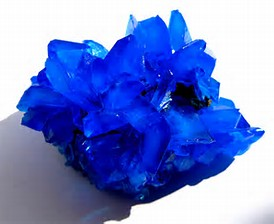CuSO_4(s)CuSO4(s) is a white solid, that is composed of Cu^(2+)Cu2+, and SO_4^(2-)SO2−4 ions, bound together by strong electrostatic forces that exist between oppositely charged ions. SO_4^(2-)SO2−4 is a charged species, an ion that we could represent as (O=)_2S(-O^(-))_2(O=)2S(−O−)2 (of course all the oxygen atoms are equivalent). With me?
Within the sulfate ion, there is a strong degree of covalency. The overall charge on this covalently bound species is -2−2; and hence is forms a salt with Cu^(2+)Cu2+ to give the required CuSO_4CuSO4.
Place WHITE CuSO_4CuSO4 in water, and you see the colour change to give a beautiful blue due to [Cu(OH_2)_6]^(2+)[Cu(OH2)6]2+ or a variant. The beautiful crystals that you see in the diagram are due to [Cu(OH_2)_5]^(2+)SO_4^(2-)*H_2O[Cu(OH2)5]2+SO2−4⋅H2O, so-called "blue vitriol"blue vitriol.
 )
)
 )
) 
